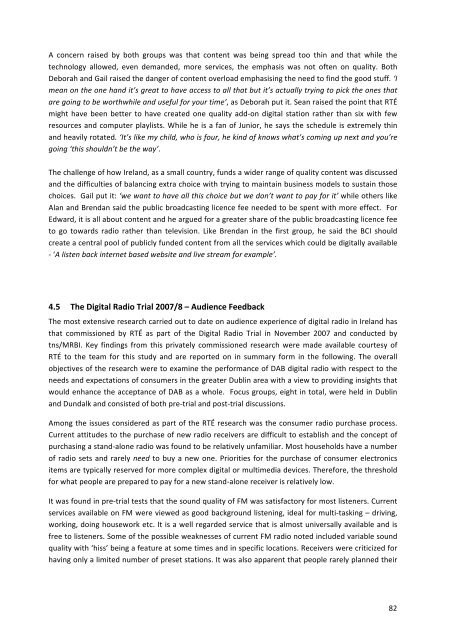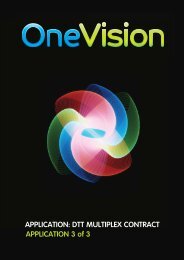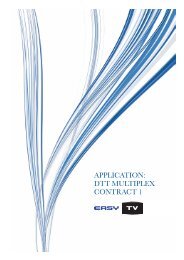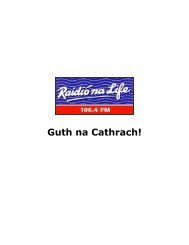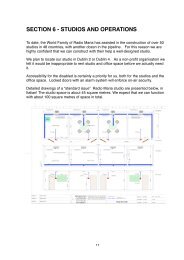Digital Radio for Ireland: Competing Options, Public Expectations - BCI
Digital Radio for Ireland: Competing Options, Public Expectations - BCI
Digital Radio for Ireland: Competing Options, Public Expectations - BCI
Create successful ePaper yourself
Turn your PDF publications into a flip-book with our unique Google optimized e-Paper software.
<br />
A concern raised by both groups was that content was being spread too thin and that while the <br />
technology allowed, even demanded, more services, the emphasis was not often on quality. Both <br />
Deborah and Gail raised the danger of content overload emphasising the need to find the good stuff. ‘I <br />
mean on the one hand it’s great to have access to all that but it’s actually trying to pick the ones that <br />
are going to be worthwhile and useful <strong>for</strong> your time’, as Deborah put it. Sean raised the point that RTÉ <br />
might have been better to have created one quality add‐on digital station rather than six with few <br />
resources and computer playlists. While he is a fan of Junior, he says the schedule is extremely thin <br />
and heavily rotated. ‘It’s like my child, who is four, he kind of knows what’s coming up next and you’re <br />
going ‘this shouldn’t be the way’. <br />
<br />
The challenge of how <strong>Ireland</strong>, as a small country, funds a wider range of quality content was discussed <br />
and the difficulties of balancing extra choice with trying to maintain business models to sustain those <br />
choices. Gail put it: ‘we want to have all this choice but we don’t want to pay <strong>for</strong> it’ while others like <br />
Alan and Brendan said the public broadcasting licence fee needed to be spent with more effect. For <br />
Edward, it is all about content and he argued <strong>for</strong> a greater share of the public broadcasting licence fee <br />
to go towards radio rather than television. Like Brendan in the first group, he said the <strong>BCI</strong> should <br />
create a central pool of publicly funded content from all the services which could be digitally available <br />
‐ ‘A listen back internet based website and live stream <strong>for</strong> example’. <br />
<br />
<br />
4.5 The <strong>Digital</strong> <strong>Radio</strong> Trial 2007/8 – Audience Feedback <br />
The most extensive research carried out to date on audience experience of digital radio in <strong>Ireland</strong> has <br />
that commissioned by RTÉ as part of the <strong>Digital</strong> <strong>Radio</strong> Trial in November 2007 and conducted by <br />
tns/MRBI. Key findings from this privately commissioned research were made available courtesy of <br />
RTÉ to the team <strong>for</strong> this study and are reported on in summary <strong>for</strong>m in the following. The overall <br />
objectives of the research were to examine the per<strong>for</strong>mance of DAB digital radio with respect to the <br />
needs and expectations of consumers in the greater Dublin area with a view to providing insights that <br />
would enhance the acceptance of DAB as a whole. Focus groups, eight in total, were held in Dublin <br />
and Dundalk and consisted of both pre‐trial and post‐trial discussions. <br />
Among the issues considered as part of the RTÉ research was the consumer radio purchase process. <br />
Current attitudes to the purchase of new radio receivers are difficult to establish and the concept of <br />
purchasing a stand‐alone radio was found to be relatively unfamiliar. Most households have a number <br />
of radio sets and rarely need to buy a new one. Priorities <strong>for</strong> the purchase of consumer electronics <br />
items are typically reserved <strong>for</strong> more complex digital or multimedia devices. There<strong>for</strong>e, the threshold <br />
<strong>for</strong> what people are prepared to pay <strong>for</strong> a new stand‐alone receiver is relatively low. <br />
It was found in pre‐trial tests that the sound quality of FM was satisfactory <strong>for</strong> most listeners. Current <br />
services available on FM were viewed as good background listening, ideal <strong>for</strong> multi‐tasking – driving, <br />
working, doing housework etc. It is a well regarded service that is almost universally available and is <br />
free to listeners. Some of the possible weaknesses of current FM radio noted included variable sound <br />
quality with ‘hiss’ being a feature at some times and in specific locations. Receivers were criticized <strong>for</strong> <br />
having only a limited number of preset stations. It was also apparent that people rarely planned their <br />
82


